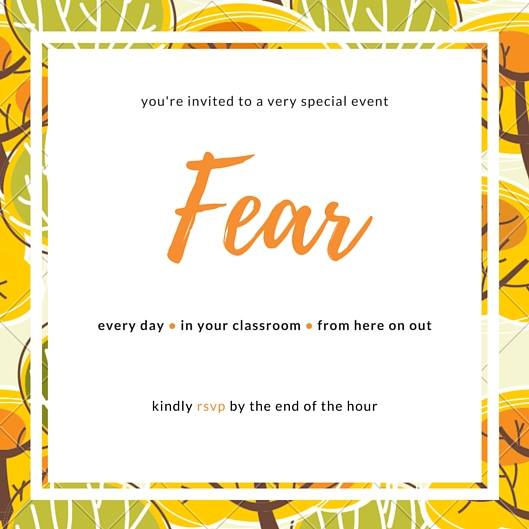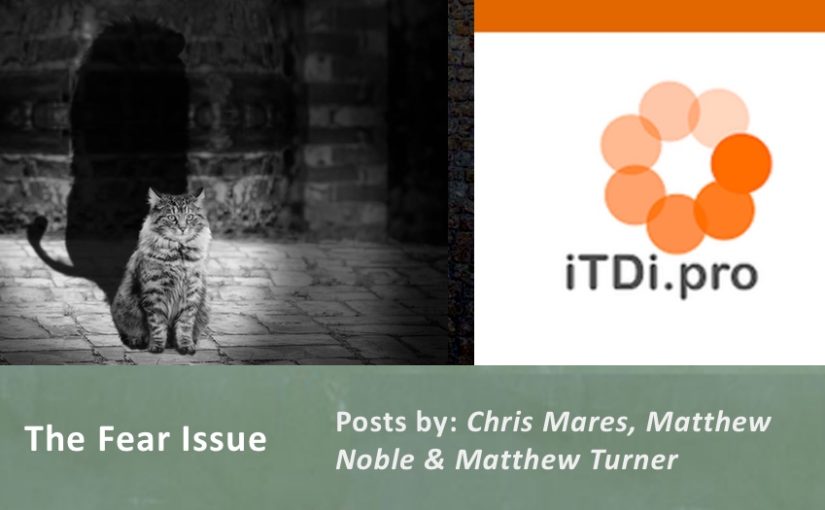 by Matthew Noble
by Matthew Noble
Last week I sent around a short questionnaire asking fellow teachers about ‘fear’. A handful of people suggested ‘fear’ wasn’t really the right word. They said ‘‘anxiety’ is more appropriate. Indeed, the term ‘anxiety’ is often found in the literature in regards to individual learners, learner groups, teachers, and its effect on motivation, learning, and (to a lesser degree) teaching.
I didn’t recall or edit the survey, though. I thought that while most respondents would automatically equate the term with anxiety anyway, sticking with ‘fear’ might prove interesting because it connotes a more objective threat and stronger emotions. Anxiety is typically associated with chronic, lingering dis-ease, while fear – with more immediate, intense, and temporary reactions in specific situations. We have anxiety about something, and a fear of something. But clearly there’s a lot of overlap. Together, anxiety and fear trace a fair bit of territory on the heart-map of the teacher’s identity which, I declare, is a land of emotion…stronger emotion than we might usually acknowledge.

In fact, right now I’d like to acknowledge that while I may not be experiencing extreme fear writing this piece for the iTDi Blog, I’m certainly anxious! What will the readers think? Is my writing okay? Just how disappointing will it be? I hear a voice within, and it’s a fearful voice. It’s saying, “someone’s going to find you out”.
Anyway, let’s get back to the survey. When respondents shared about fears they remember from their early days as teachers, what do you think was front and center? The most common thread running through their accounts was the often intensely fearful “impostor syndrome”:
“I was afraid of students finding out how much I relied on the textbook because I was just learning how to be a teacher, and I did not have any formal training in TESOL…”
“…Screwing up complicated classroom management or a task set up and that someone would realise what an impostor I was…”
“The first time I taught I had butterflies in my stomach, I was afraid of being labeled ‘stupid’, of not knowing something I should know (‘my native language’), of being asked questions and having no answer, of being an impostor…”
Does any of that ring a bell? Or perhaps flap a butterfly wing? The next question asked about fears they encountered as more experienced teachers. The responses here were more varied, as well as much more specific.
1 – “I fear students get confused about my instructions or writing prompts”
2 – “Now and then think I may someday get bored or tired and want to leave the profession”
3 - “My fear now is that my students (who pay for English classes) won’t get their money’s worth out of the class”
4 – “Now that I am into teacher training I am afraid that I might project my own perceptions of good/bad teaching on my trainees”
5 – “I still always get nervous when facing new classes”
Interestingly, to me these read more like ‘fears’ than the first batch. Do we tend to shift from experiencing a more overarching ‘anxiety’ to having more ‘focused fears’ as we develop? Another thing to note is that many responses in the first question about the early teaching days ignored the prompt to report what they did in the face of the fear they experienced. In contrast, there was much more about facing the fear and responding to the situation in connection with more recent fears. And since I’m a teacher, I’m now going to have you do a little matching task with some of these comments. Match the four responses A-D below with the items 1-5 above. Yes, there’s one without a match! (Answers below)
A – That’s why I always talk to them in regards to specified criteria
B – I get feedback from students about class activities
C – I always try new things and seek further professional development
D – I think it’s a good thing and I try to stay open to new experiences
These comments reflect the resilience and resourcefulness teachers develop over their careers. It’s not that anxiety or fear in the face of problems disappears. Rather, there’s a shift. Expert teachers have been described as “working at the edge of their competence”, thereby maximizing opportunities for both encountering and solving problems. They invite challenges, lean into them, and live the questions that once caused fear. And as they develop they increasingly live out the famous Maya Angelou quote, “Having courage does not mean that we are unafraid. Having courage and showing courage mean we face our fears.”

Respondents to my survey also identified what they thought were common teacher fears. Can you relate to any of these? Take a minute to simply reflectively connect one or more of them to your own experience. These are memories of the past, but what might you take out of this recall and reflection for tomorrow? If there is fear or other negative emotion around it, what could be your first step through it?
“That they may be missing out on something else career-wise”
“A lot of teachers just want their students to like them, but fear they don’t”
“Not feeling respected and appreciated for their hard work”
“Murphy’s Law and technology – constantly on edge: will it work?!?”
Finally, some of the additional prompts teachers offered for reflection on teacher’s fear and anxiety:
“The impact of fear is on teacher’s professional development choices. Does it spark a bigger desire to learn or does it paralyze the teacher? Sort of like what happens with anxiety, which can be positive if it is not overwhelming”
“I really enjoy being in the class and feel comfortable 99% of the time, but I am busy and I have been worried about exhaustion and burnout”
“Do teachers feel that their English proficiency causes them fear as well?”
“Teachers need to know they do not know everything. Putting our defences down is a great way to open our hearts and learn from students”
If one of those prompts (or anything else here) inspires you to respond, please don’t be afraid to do so in the comment box below, or on twitter, or on your own blog! Because what is very clear to me is this: the negative side of fear thrives in isolation. Dan Lortie called teaching “the egg-carton profession” because we may work in close proximity to our peers but too rarely connect and collaborate in important ways. As one of my respondents commented, “Schools should have an open door policy and teachers should walk in and out of each other’s teaching rooms!”. Now that’s unafraid! And it’s beautiful. It’s also, unfortunately, unrealistic. So while we keep working to break down the more physical walls, we should use the connective vessel of the internet to share thoughts, experiences, and especially emotions with colleagues through social media and teacher networks like iTDi. This is one powerful way for teachers to beat fear and be free.
Matching task answers: 4 – A, 1 – B, 2 – C, 5 – D.












